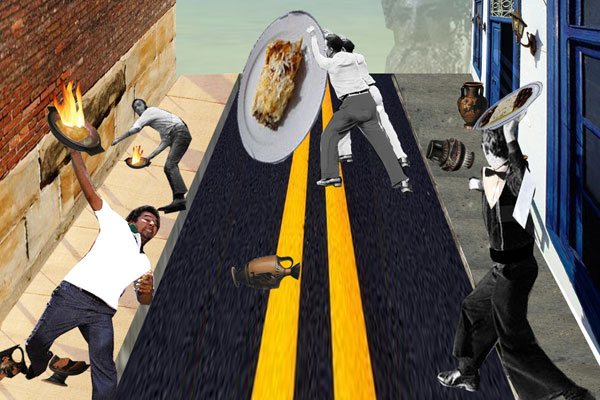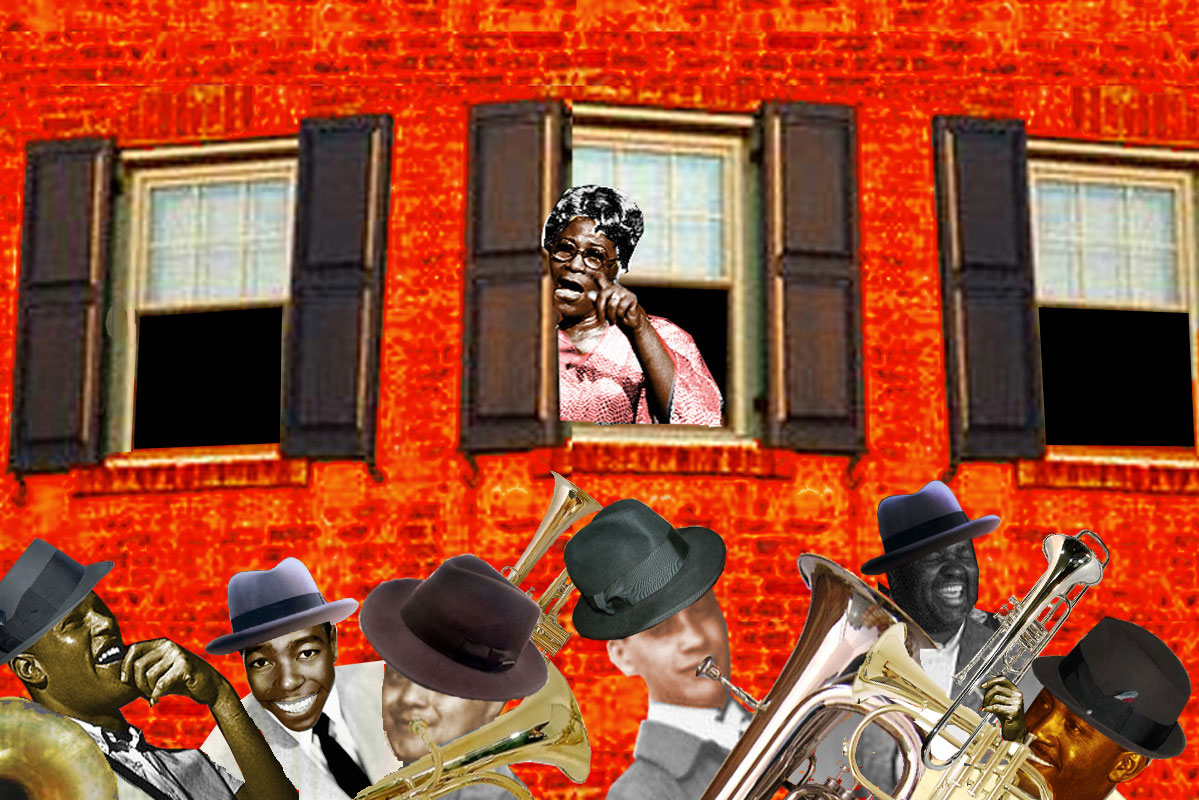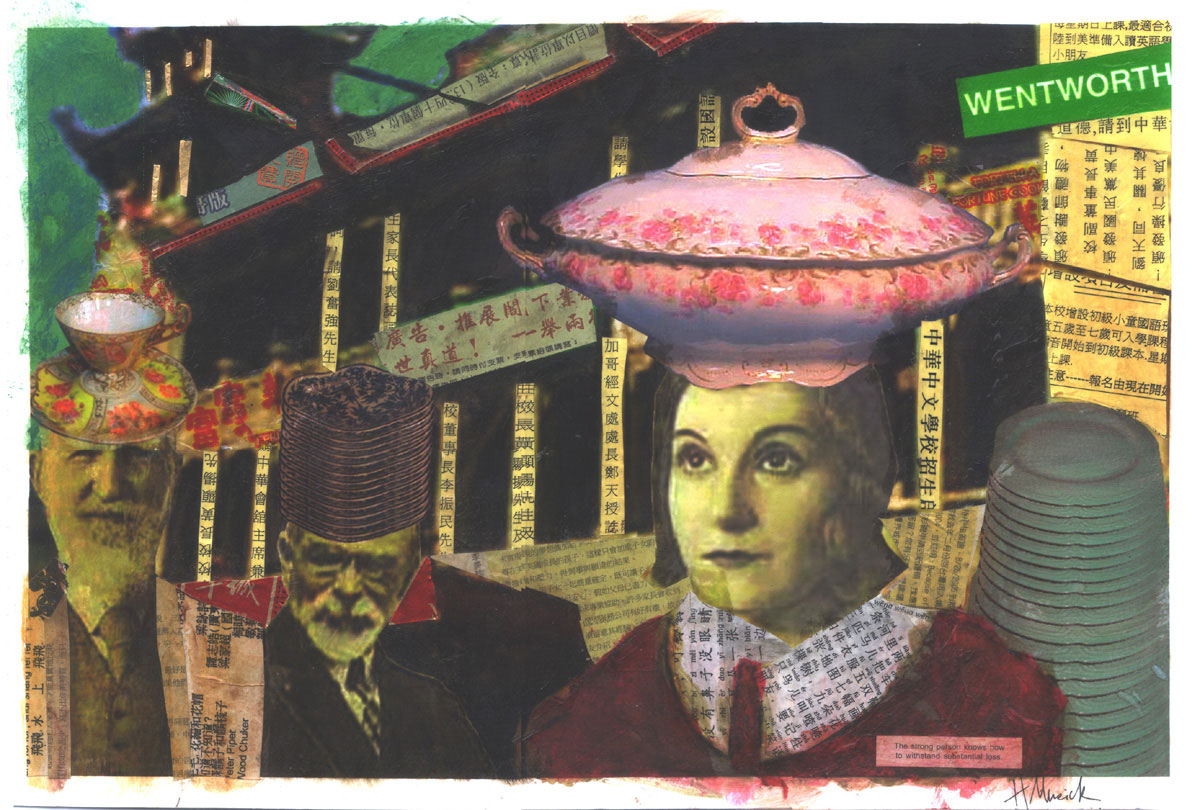The Neighborhoods Project
In June 2005 as the Chicago Department of Cultural Affairs Open Studio Artist I began work on a series of large format postcards (18"x12") depicting Chicago neighborhoods. My goal is to complete one postcard for each of Chicago's seventy-four neighborhoods. My method is to first create a digital collage that serves as a template for a final piece. Once this is laid out I travel to the neighborhood and collect scraps of a paper off the streets that I then overlay onto the digital collage. In this way, the postcards have a physical connection with each neighborhood. When completed works will be reproduced at 4 ft. x 6 ft. with additional collaging layered upon this final piece. A more lengthy description of this entire project can be heard on an archived edition of WBEZ's 848 with Steve Edwards that aired on Tuesday, June 28, 2005. http://www.chicagopublicradio.org/audio_library/848_rajun05.asp#28
The building and clothing is made up of scraps of ephemera picked up off the sidewalk and street on Wentworth Avenue in June 2005. Scraps include ads from a chinese language newspaper, fliers, chinese cigarette packs, a children's chinese language lesson sheet, fortune cookie wrapper and fortune. The fortune reads: "The strong person knows how to withstand substantial loss."

Greektown (Digital Sketch)
The Sack of Troy Taverna
Venture to the southwest corner of North Halsted and West Adams in Chicago’s Greektown and you will comes upon an archeological dig far greater than any other in the Midwest. There, historians, archeologists and food enthusiasts work tirelessly to unearth remnants of a great war waged in this neighborhood’s streets many years ago. Among the more important recent finds was a weathered paper placemat inscribed with the tale of the war’s origins. Translated from the Modern Greek, it reads:
Sing Muse of fair Helen, the hostess who launched one thousand tips, and the battle for her that raged on Halsted Street for eighteen days. What god was it that set Nick Alexandros, proprietor of Troy Taverna, to lure Helen of the golden hair from her esteemed station at the entrance of Gus Menelaos’s Sparta Grille? Did Helen of the white arms willingly return to Troy Taverna because of Nick’s charms or was it his offer of full-benefits that led her astray? Speak then of gus’s loyal waiters who took up arms against the warrior-like waitstaff of the Troy Taverna and hurled many a flaming saganaki across the street in a drive to return Helen to her rightful leatherette throne back at the Sparta Grille.Today, visitors to Greektown can stand in the footsteps of great waiter warriors and on top of calcified relics like the great Moussaka bombs that helped secure Helen’s return.

Edison Park (Digital Sketch)
The Illuminated Gardens at the End of the World
Back in the 1890s pioneering Chicagoans answered the call to “Go West, Young Man,” by venturing to the very edges of the city limits to establish outposts for trading with the exotic Suburbarbarians. Those who reached the city’s far most northwest corner dubbed the area Ebson Park in honor of the first settler, Merriweather Ebson.
Prosperity came to the area quickly as demand for the colorful golf clothing sported by the Suburbarbarians became all the rage downtown. Frontier trade, coupled with the successful cultivation of cannolis, caused the area’s population to surge. However, in 1899, City Hall imposed steep tariffs on the delightful, marscapone-filled desserts, leading to calls for secession. Ebson Park seemed poised to break off from the city when the electrical wiring of nearby Norwood Park resulted in reconsideration and then a dramatic reversal by local leaders.
The wiring of Ebson Park became something of a mania for area residents. They took to wiring every inch of the neighborhood. The most breathtaking example being the dramatic illuminated gardens. Neighbors went to great lengths trying to outdo one another, embedding the newly created lightbulb into flowers. As the Sun fell, the neighborhood lit up, casting a beautiful multi-colored light over the entire area. In tribute to the inventor of the light bulb, the region was renamed, Edison Park. This tradition lasted for most of the summer of 1899, until residents received their first electric bills. Thereafter, the neighborhood was rewired along more modest lines.

Bronzeville (Digital Sketch)
The Short Reign of Brassville
Bebop Fever infected the students of Wendell Phillips High School in the spring of 1943. Those in the school brass band were particularly taken with it. As the school year drew to a close, band members assembled and agreed to devote the whole of their summer to exploring this radical new jazz form.
The students’ initial forays into Bebop improvisation took place on the baseball field behind the high school. However, after several days, members of the Bronzeville Audubon Society filed a complaint with school administrators claiming that the atonal squawks and honks coming from the students’ horns were scaring off area birds. It came as something of a relief to the school principal, William Howard to ask the fledgling hipsters to move their rehearsal space off campus.
The next gathering place was a garage at the corner of 41st and State Street owned by a band member’s father. When neighbors complained about the “unholy racket” coming from the garage the musicians found themselves once again with no place to explore their new sound.
One June afternoon, the young men of Bebop laid claim to a patch of sidewalk in the 4300 block of South Michigan Avenue, declaring it the newly formed neighborhood, Brassville. Unfortunately, one Mrs. Winifred Wilkins saw to it that the Brassville would never be. Leaning out of her apartment window, she halted the students’ version of Begin the Begeen mid note. She yelled down to the young men on the sidewalk below that she knew each one of them and that she would not hesitate to call their grandmothers if they did not stop immediately. Rendered silent by this pronouncement, the musicians disbanded and spent the remainder of the summer just listening to records.






